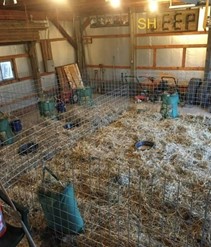 The versatility of sheep offers a gateway into sustainable land management and food production, a low input meat source and an overall easy-care animal for a variety of individuals. As the number of small-flock EAPK members increases, the appeal for a befitting column has cropped up. Whether you are a new shepherd, small holder, homesteader, CSA farmer, or hobby farmer, there are some unique features to how small producers operate.
The versatility of sheep offers a gateway into sustainable land management and food production, a low input meat source and an overall easy-care animal for a variety of individuals. As the number of small-flock EAPK members increases, the appeal for a befitting column has cropped up. Whether you are a new shepherd, small holder, homesteader, CSA farmer, or hobby farmer, there are some unique features to how small producers operate.
As small producers, we typically fabricate almost every component of our sheep operation. This allows us to keep costs low and suit everything to our needs as small holders. One of the questions that we often hear surrounding lambing is how we set up our jugs and lambing area. We lamb in March or April and our climate is unpredictable, usually offering a snow storm or extreme conditions during lambing season.
Originally, we needed something that was cheap, temporary, and could be tucked away easily for the rest of the year. We considered pallets but they were bulky and heavy. We decided to use goat panels but any wire panel will work. They were cut with an angle grinder to construct 5′ x 5′ boxes (jugs) within a larger pen attached to the garage-style door leading to an adjacent paddock. It’s important to grind the sharp cut edges down until they are blunt and smooth to prevent injury. We used corkscrew style panel hinges to keep it all together. Buckets, hay bags, and supply baskets are easily clipped or hung from this style of jug which keeps everything accessible and convenient.
 When lambing is complete, we can remove jug walls to create a small area for bottle lambs (hopefully not!) or remove them entirely to increase the pen size for ewes and lambs until it’s time to return to pasture. When the sheep are on grass again, we disassemble everything and tuck it against the wall. The panels are easily repurposed for a hospital area, handling pen, or transport crate. If wood panels or pallets are what you have to work with, try using four eye bolts and a sturdy rod to construct jugs or attach panels to barn walls. An eye bolt on each panel on top and bottom should work well. This solid but temporary method of construction allows for versatility and movement of your system. I picked this trick up from another small producer. Genius!
When lambing is complete, we can remove jug walls to create a small area for bottle lambs (hopefully not!) or remove them entirely to increase the pen size for ewes and lambs until it’s time to return to pasture. When the sheep are on grass again, we disassemble everything and tuck it against the wall. The panels are easily repurposed for a hospital area, handling pen, or transport crate. If wood panels or pallets are what you have to work with, try using four eye bolts and a sturdy rod to construct jugs or attach panels to barn walls. An eye bolt on each panel on top and bottom should work well. This solid but temporary method of construction allows for versatility and movement of your system. I picked this trick up from another small producer. Genius!
A temporary set up has always been a priority as our lambing area is my husband’s building (he told me to put that in here). We use Zeolite mineral-based granules (PDZ Refresh) to absorb urine and barn odor from the concrete floor. Spread generously and left to work, there is no remaining “sheep” odor the rest of the year. We also use this granular refresher to eliminate ammonia in between bedding changes during lambing. Zeolite is pricier than barn lime, but does not affect hooves, eyes, or respiratory tracts.
When you have a small flock, you have to adjust industry norms to suit your space and the size of your operation. Creativity and a little skill go a long way when adapting your farm for small flock production. Remain clever in your operation design and share alternate ideas with other small farmers to maximize your potential as a small flock producer.
By: Allison Rudd, Oxberry Farm, EAPK Member
![]()


